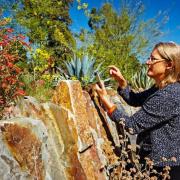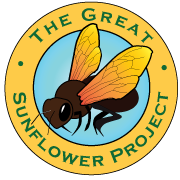You can count pollinators wherever you go and on any plant. You can even count if you can't identify the plant species. 
We have several different types of counts that can accommodate everything from a stop in a garden to counting pollinators along a walk.
Stationary Count (This is what our normal Great Sunflower Count fits in and can be used for observations of single plant species.)
Observations made over a known period of time watching a flowers or known number of flowers on a single plant species are classified as a Stationary Count. If you move from one plant to the next, you should consider entering your observations as a Traveling Count or an Area Count. Examples of Stationary Counts are: a traditional Great Sunflower Project 15 minute count or observing hummingbirds visiting at a single plant for any length of time Required: Plant species, Number of flowers observed, Date, Start Time, and End time.
Traveling Count (This is what you report if you were taking a walk and observing pollinators.)
Observations made over a known period of time while traveling a known distance are classified as a Traveling Count. You should be able to estimate the distance that you traveled during your outing. If you do have a reliable estimate of the area you covered while you recorded the species, consider entering your observations as an Area Count. If you aren't sure of the distance or area you covered, please enter your observation as a Casual Observation. Examples of Traveling Counts are: walking a trail at a local park or walking a path through a botanic garden. Required:: Date, Start Time, End time, and Distance Covered.
Area Counts
Observations are made while thoroughly searching a given location or area. These types of counts are sometimes used by biologists when monitoring a specific site- often a one hectare plot, however, they can be appropriate for sampling bees if you are able to estimate the size (acres or hectares) of the area you searched. The key measure of effort is the size of your area. Secondary measures of effort are time (duration) and distance traveled. If you are unsure of the area you covered, but have a reliable estimate of distance, consider entering your observations as a Traveling Count. Examples of Area Counts include: actively searching a local park or woodlot for pollinators. A pollinator trek around your schoolyard, neighborhood or privately owned property can be an Area Count if you are able to estimate the size of the area you searched. Required:: Date, Start Time, End time, and Area Covered.
Casual Observation
Observations that involve no time or distance/area components are classified as Casual Observations. Examples of an Casual Observations are: a bumble bee that flies by while you are checking your mail, an Anna's hummingbird feeding in your backyard while you wash dishes, or a honey bee visiting flowers while you are weeding your garden. Required: Date.
